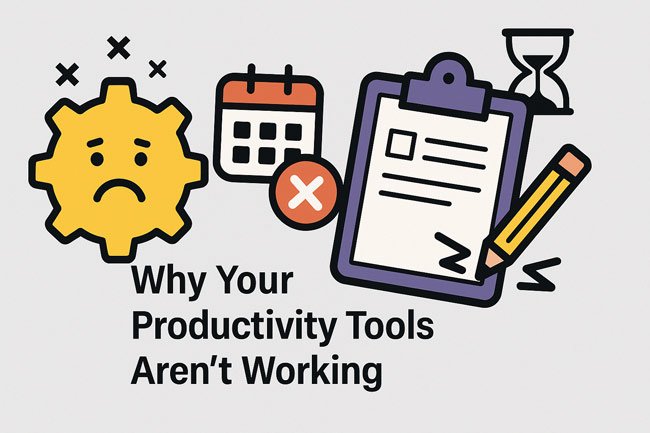We live in an era where every problem seems solvable with an app. Can’t focus? There’s a tool. Too many tasks? Another tool. Overwhelmed? A dashboard. A timer. A color-coded miracle waiting in the App Store.
And yet, despite all this digital abundance, people feel more unproductive than ever. The truth is uncomfortable but liberating: Your productivity tools aren’t necessarily failing. They’re revealing the parts of your life that no tool can solve for you.
What feels like a discipline issue is usually a design issue in disguise. It’s about how you search systems, interpret your own patterns, and filter advice in a world that keeps nudging you toward “optimization” instead of clarity.
Let’s slow down the noise and walk through the actual reasons productivity tools fail and what genuinely works instead.
1. You’re Solving the Wrong Problem
Most people download a tool after they’re already overwhelmed.
The thinking goes: “If I organize everything, I’ll finally feel in control.”
But being overwhelmed is a perspective issue, not a software issue.
If you want proof, take a breath and read: How I Search for Peace Online: Finding Calm in the Age of Algorithmic Noise.
It’s the same principle—if you treat chaos as a software problem, you’ll always choose the wrong solution.
Productivity tools don’t fix anxiety and frustration; they map them. And sometimes seeing everything clearly only makes the weight feel heavier.

2. You Adopt Productivity Tools Designed for Someone Else’s Life
People often choose productivity tools based on admiration rather than fit.
You watch a YouTuber with a neon-lit desk and a ten-tab dashboard and think: “If it works for them, maybe it’ll work for me.” But tools are like shoes. You can admire someone else’s shiny high heels without being able to walk in them.
If your days are unpredictable, rigid systems will suffocate you.
When most people say they want a “minimalist routine,” what they’re actually imagining is one of the polished productivity systems we see online: the aesthetic Notion dashboard, the one-habit-a-day challenge, the perfectly stripped-down task list, the rigid weekly template, the zero-distraction workflow, or the fantasy that a single tool could organize an entire life. These systems are designed for predictability. They thrive on sameness, structure, and repeatable days. And while they work beautifully for the people who live inside that kind of rhythm, they fall apart instantly for anyone juggling caregiving, creative work, deadlines, emotional labor, or the sheer unpredictability of modern life. Real life isn’t symmetrical like minimalist systems are.
You don’t need a “better system.” You need a system shaped like your life.
3. You’re Searching for Productivity Tools, Not Causes
This is the big one.
People search for “best productivity apps” instead of:
“Why do I procrastinate at 3 pm?”
“Why is decision-making harder than finishing the actual work?”
“What parts of my day drain me the most?”
Productivity tools answer what. But your life improves when you search for why.
That is the same approach used in: The Modern Health Detective: How to Research Health Topics in the Age of AI and Disinformation.
The better your question, the better your solution. Your productivity problems are patterned, not random.
Tools can support those patterns, but they can’t diagnose them for you.
4. You’re Fighting Your Brain Instead of Working With It
Some people believe that productivity is essentially about willpower, when it’s actually about rhythm. Your brain works in natural cycles of high focus, drift, fatigue, recovery, and curiosity. Most productivity tools force you into artificial patterns that punish fluctuation.
That is why people say, “I work best at night,” or “I crash in the afternoon,” or “I get my energy back after dinner.” They’re describing biology, not merely quirks.
If this fascinates you, you’ll love: The Silent Miracle: How Your Gut Whispers to Your Brain and Cultivates Inner Peace.
Your entire body participates in your productivity—not just your mind. A tool can organize tasks, but it cannot override your wiring.
5. You Confuse Motion With Progress
When life feels chaotic, organizing things feels like a step in the right direction. But reorganizing your task manager is not the same as completing tasks. Color-coding is not a strategy. Rewriting lists is not forward motion.
A clean dashboard is not clarity. Productivity tools let you simulate momentum without actually moving.
The real work often looks quieter and less glamorous:A single important task. A conversation you’ve been avoiding. A decision you’ve delayed for months.
One step can break the mental logjam. Actual productivity is not movement; it’s the direction you move towards.
6. You Expect Productivity Tools to Replace Personal Truths
Here’s the most human part of all:
You don’t need an app to tell you what matters. Your life already tells you every day. The tasks you avoid, the tasks you crave, the tasks that drain you, and the tasks that energize you are directional clues.
Tools help you track reality, but they cannot invent meaning or purpose. They cannot choose priorities for you, heal burnout, redefine ambition, or force your life into a template that doesn’t fit.
Your most powerful productivity strategy is brutally simple: Know yourself. Then choose tools that bend to you, not the other way around.
What Actually Works (and Works Long Term)
Here are the systems that consistently outperform tools, apps, and dashboards:
1. One Source of Truth
Pick one home base—paper, digital, hybrid, doesn’t matter. Everything lives there, and everything returns there.
2. A Daily Debrief
Ask three questions:
- What drained me today?
- What worked?
- What do I want tomorrow to feel like?
Just five minutes of reflection can give you more clarity than an hour of reorganizing tools.
3. Micro Planning Instead of Mega Planning
Plan the next 12 hours, not the next 12 weeks. Your brain responds to immediacy, not fantasy.
4. Reduce Inputs, Not Effort
We mistake productivity for effort, but half the battle is simply lowering the volume of our digital environment with fewer apps to juggle and fewer alerts competing for attention. Less background noise pretending to be urgent. The quieter the world gets, the easier it becomes to hear your own priorities again.
You’d be shocked at how much productivity rises when algorithmic overload drops.
5. Default Decisions
You’d be shocked at how much smoother life feels when we simplify a few things, like what you eat in the morning, how you start a Tuesday, and the handful of chores you always do at the same time. These small defaults eliminate dozens of tiny decisions that quietly drain your focus. It’s the most straightforward productivity hack most people never try.
Defaults save more energy than any time-tracking app has ever been able to.
The Real Reason Your Tools Don’t Work
The real reason your tools feel useless isn’t a lack of discipline or the wrong app. It’s that productivity doesn’t begin with software at all. It starts with clarity—an honest understanding of what matters, how your brain works, and the rhythm your life naturally follows. Once you have that, even a simple system becomes powerful. Skip that part, and even the most polished app will collapse under the weight of your real life.
And when you get it wrong, no tool in the world can save you.
If you want tools that actually respect your attention instead of cannibalizing it, here are a few worth exploring. (As an Amazon Associate, we may earn a small commission from qualifying purchases, at no extra cost to you.)
Product | Why It Helps |
A modern time-blocking tool that makes focus simple. The visual countdown and tactile flipping reduce friction and help you commit to a single task at a time. | |
A simple preset timer (5/10/25/50 min) that you flip to start, ideal for focused work and ADHD-friendly routines. | |
A reusable notebook that blends handwriting with digital storage, so you can think on paper and still keep everything organized in the cloud. | |
A minimalist wide-angle desk lamp that reduces eye strain and keeps your workspace evenly lit for long, focused sessions. | |
Keeps your most-used tools visible and within reach, clearing surface clutter and making your desk feel calmer and more intentional. | |
Fast, stable charging for multiple devices at once, so your laptop, phone, and tablet stay powered without juggling adapters. | |
Lets you work comfortably from the couch, bed, or anywhere, while keeping your laptop stable and at a better angle. | |
A compact, quiet keyboard that can switch between devices with a button press, ideal for working across laptop, tablet, and phone. | |
Reduces digital eye fatigue so you can stay at the screen longer without the same level of strain or headache. | |
Clean, precise pens that make note-taking and planning feel smoother and more enjoyable, which encourages you to actually use your systems. |
According to the APA (American Psychological Association) multitasking drains cognitive energy, which makes tools feel ineffective when clarity is missing.










